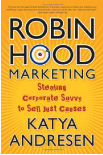Communications is the orange juice of the nonprofit world: it’s not just for fundraising any more. Many organizations are using social marketing to change the way people behave.
- Cigarettes used to be cool and sexy. Now they are seen as a public health hazard.
- Drunk driving was the topic of jokes. Now it’s seen as criminal behavior.
- Binge drinking is currently being redefined from college hijinks to a serious problem with alcohol.
Are you using social marketing? How? What results have you seen?
Social Marketing: Good for Your Health
Social marketing is “the systematic application of marketing, along with other concepts and techniques, to achieve specific behavioral goals for a social good.” If getting a lot of people to change their individual behavior over time will let you reach your goals, then social marketing may be a powerful tool for you.
How powerful? In her book Robin Hood Marketing, Katya Andresen tells the story of how a nonprofit in Cambodia–a country known for its sex industry–convinced men to wear condoms. Beth Kanter summarizes:
A journalist, [Andresen] was covering a World AIDS Day event in Phnom Penh. She saw how the giant condom-shaped balloon emblazoned with the words “Number One” was attracting attention and scores of people were grabbing up free samples of condoms….
As she writes in the introduction of her book, “For once, I heard no doom-filled message of fear or shame. In its place was an appealing sense of pride and fun.” As it turned out the giant condom was part of a business-minded marketing approach by a nonprofit organization, Population Services International (PSI)….
She points out that PSI condoms are now available in virtually every brothel in Cambodia, helped by a law that has since mandated condom use in sex establishments.
Social marketing can change something as personal and ingrained as sexual behavior. What problem are you tackling that’s more difficult than that?
How Social Marketing Works
People buy a product for many reasons besides the product itself. They may like the image they think it gives them, or the people or values associated with the product. “Think different” is not a feature of Apple computers. It’s a vision of the kind of person who uses Apple computers. Wanting to be that kind of person has made a lot of people buy Apple.
People “buy into” your social marketing campaign for many reasons, too. The American Legacy Foundation’s truth campaign
tapped into adolescents’ need for independence, rebellion, and personal control by presenting appealing social images of a nonsmoking lifestyle–cool kids living without tobacco. According to research, the decline in youth smoking attributable to this campaign equates to some 300,000 fewer youth smokers and thus millions of added life years as well as tremendous reductions in health care and social costs.
One technique that I find appealing is simply showing your target audience, “No, everybody isn’t doing it.” Spreading the message that the vast majority of college students are moderate drinkers, not binge drinkers, has gone a long way toward stigmatizing the extreme behavior of the few.
Should You Be Using Social Marketing?
The easiest examples of social marketing to find are in the field of health. That is certainly not the only area in which it can be useful. In the U.S., the Washington D.C.-based organization “Men Can Stop Rape” anti-rape movement have successfully used social marketing in posters and other media targeting a rape-prevention message at boys and young men. And it can also work for more affirmative goals, like getting people to enroll in literacy courses.
Has your organization ever used a social marketing campaign? What results did you see?
Are you considering using social marketing to change behavior in your community? What would you like to learn before you start?

